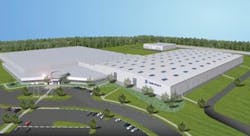Turbine Technology: Crosspointe
Rolls-Royce has a plan and the acreage to go with it.
It has 100,000 acres in Prince George County in Virginia where it plans to build an industrial park. It will include manufacturing, education and research, along with room for its suppliers.
The site was chosen for its location. Nearby rail lines and Interstates 95, 295 and 64 will ease transporting equipment and parts throughout the United States. And the port of Hampton Roads will enable exporting of products and equipment. Major universities in the state will help develop new manufacturing and engineering technology and a local college will train future employees: University of Virginia, Virginia Tech, and John Tyler Community College.
Initial Rolls-Royce investment in this site is $170 million. Over time, the company anticipates total investment of approximately $500 million in Virginia. The first phase will support roughly 140 jobs; the company expects future growth in Virginia to generate some 500 jobs in the coming years.
Tom Loehr, Rolls-Royce executive vice president, Crosspointe, says: “Our improving market position and significant growth in the past few years have delivered a record order book.
Despite these challenging times, we are confident in our long-term growth and determined to maximize the opportunities provided by our technologies, people, and global reach.
“Thanks to our partners, the Commonwealth of Virginia, Prince George County, the University of Virginia, and Virginia Tech, Crosspointe will be a world-class aerospace facility and will play a key role in our future. We’re delighted to be growing our footprint in Virginia and bringing the economic benefits associated with high value-added manufacturing to the region.”
Crosspointe will be the largest Rolls-Royce site by area in North America, with space to accommodate suppliers’ and partners’ co-location in the future. It is the first Rolls-Royce site built from the ground up in the United States.
“Rolls-Royce is investing in America,” says James M. Guyette, president and CEO, Rolls-Royce North America. “Crosspointe will be a flagship operation for Rolls-Royce, and the significant investment we are making here will enhance our competitiveness in global markets and position us for future growth.”
Manufacturing
The first building will be a 140,000-square-foot engine disc manufacturing facility. Discs manufactured at Crosspointe Center will be used in the Trent line, 1000, 900 and XWB for the Boeing 787, Airbus A380, and A350 XWB. Disc production will begin as soon as the site is operational, expected to be the fourth quarter of 2010.
The second building will be dedicated to blisk manufacturing. Blisks, or bladed discs, incorporating fan blades and discs into a single piece, are designed for use in the next generation of gas turbine engines. They will be used in the F136 engine for the Joint Strike Fighter.
University partners
Education outreach is a major part of the overall project. As envisioned, engineering professors and students from Virginia Polytechnic Institute and State University (Virginia Tech) in Blacksburg, VA, and the University of Virginia in Charlottesville, will take part in activities related to Rolls-Royce’s factories. Professors may take two-year sabbaticals while graduate students do hands-on research at the facility for their master’s or doctoral papers. Their efforts will be coordinated at the new Commonwealth Center of Advanced Manufacturing (CCAM) that will be built on the Rolls-Royce land at Crosspointe Center.
Barry Johnson, University of Virginia, and Don Leo, Virginia Tech, along with Rolls-Royce officials talked to Aircraft Maintenance Technology last fall. With the amount of engineers in Virginia, it’s a good fit. The University of Virginia research projects include coatings, corrosion, and combustion. Virginia Tech research focuses on flow control, electronics, and coatings.
The Crosspointe campus will accommodate CCAM, a partnership founded by the Commonwealth of Virginia, the University of Virginia, Virginia Tech, Rolls-Royce, and other partners. The vision for CCAM is to become a world-class research facility delivering new technologies in design and manufacturing.
University programs will include internships, faculty sabbaticals, visiting faculty, sponsored research, lab renovations, chaired professorships, and graduate student support. Rolls-Royce will be directing funds to the universities so additional faculty can be added. CCAM is also looking for federal grants and additional partners to fund the research.
Two levels of membership will be available, tier one is Rolls-Royce and other tier one suppliers, level two will encompass the tier two supply network.
In addition, the Commonwealth Center for Aerospace Propulsion Systems (CCAPS), a virtual research and technology center of excellence established by the same partners, creates a framework in which to approach the technology needs of tomorrow. Crosspointe is the second such university center in the United States, Purdue was the first.
Workforce development
Rolls-Royce envisions needing as many as 500 skilled workers for its manufacturing plants. Two-year training programs will be developed so that Rolls-Royce will have the workforce it needs. The advanced machine tools and other devices used to make jet engines will require a sophisticated work force.
Community college students in the Richmond area will use the factory and the CCAM to provide two-year associate engineering degrees.
John Tyler Community College, a two-year college, will develop a manufacturing certificate along with an associate degree. With locations in Chester, Midlothian, and Richmond, VA, it will enable direct exposure to company training and internships to grow the future work force.
A plan and the partnerships to make it happen: a new center for the aerospace industry.
